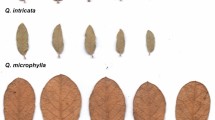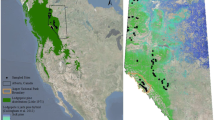Abstract
It has been hypothesized that environmental variability can influence the sex ratio of a plant population, and it has been observed that in stressful environments, male plants are more abundant than females. However, it is unknown whether this is due to differential mortality rates between males and females. In this study, we analyzed sex ratio, mortality, and size distribution in a population of the neotropical tree/bush Bursera fagaroides in two different environments (east- and west-oriented slopes) over a 10-year period. We determined that the sex ratio favored males in the more stressful environment (east-facing slope) and that females were significantly larger in the less stressful environment (west-facing slope). Despite a significant difference in size between sexes by slope aspect, the difference in sex ratio cannot be explained by slope or by mortality during the 10 years of observation.
Similar content being viewed by others
References
Allen GA, Antos JA (1993) Sex ratio variation in the dioecious shrub Oemleria cerasiformis. Am Nat 141:537–553
Amezaga I, Mendarte S, Albizu I, Besga G, Garbisu C, Onaindia M (2004) Grazing intensity, aspect, and slope effects on limestone grassland structure. J Range Manag 57:606–612
Auslander M, Nevo E, Inbar M (2003) The effects of slope orientation on plant growth, developmental instability and susceptibility to herbivores. J Arid Environ 55:405–416
Bierzychudek P, Eckhart V (1988) Spatial segregation of the sexes of dioecious plants. Am Nat 132:34–43
Carroll SB, Mulcahy DL (1993) Progeny sex ratio in dioecious Silene latifolia (Caryophyllaceae). Am J Bot 80:551–556
Charnov EL (1982) The theory of sex allocation. Princeton University Press, NJ, Princeton, USA
Chmura D (2008) The slope aspect affects the heterogeneity and growth of ground flora vegetation in deciduous temperate forest. Pol J Ecol 56:463–470
Cipollini ML, Stiles EW (1991) Costs of reproduction in Nyssa sylvatica: sexual dimorphism in reproductive frequency and nutrient flux. Oecologia 86:585–593
Dawson TE, Ehleringer JR (1993) Gender-specific physiology, carbon isotope discrimination, and habitat distribution in boxelder, Acer negundo. Ecology 74:798–815
Decker KL, Pilson D (2000) Biased sex ratios in the dioecious annual Croton texensis (Euphorbiaceae) are not due to environmental sex determination. Am J Bot 87:227–229
Dubayah RC (1994) Modeling a solar radiation topoclimatology for the Rio Grande basin. J Veg Sci 5:627–640
Duberceucq D, Geissert D, Moreno P, Millot G (1992) Soil evolution and plant communities in coastal dunes near Veracruz, México. Cah Orstom Ser Pédol (France) 26:237–350
Erefur C, Bergsten U, de Chantal M (2008) Establishment of direct seeded seedlings of Norway spruce and Scots pine: effects of stand conditions, orientation and distance with respect to shelter tree, and fertilisation. For Ecol Manag 255:3–4
Falinski JB (1980) Vegetation dynamics and sex structure of the populations of pioneer dioecious woody plants. Vegetation 43:23–38
Ferrer D, Calvo J, Esteve-Selma MA, Torres-Martínez A, Ramírez L (1995) On the use of three performance measures for fitting species response curves. J Veg Sci 6:57–62
Flores-Palacios A, Ortiz-Pulido R (2005) Epiphyte orchid establishment on termite carton trails. Biotropica 37:457–461
Freeman DC, McArthur ED, Sanderson SC, Tiedeman AR (1993) The influence of topography on male and female fitness components of Atriplex canescens. Oecologia 93:538–547
Geber MA, Dawson TE, Delph LF (1999) Gender and sexual dimorphism in flowering plants. Springer Verlag, Berlin
González-Hidalgo JC, Bonet A, Echeverría MT (1996) Efecto de la orientación de la ladera sobre algunas comunidades arbustivas del semiárido central de la depresión del Ebro. Mediterranea. Serie de estudios biológicos, pp. 21-31
López-Villalobos A, Flores-Palacios A, Ortiz-Pulido R (2008) The relationship between bark peeling rate and the distribution and mortality of two epiphyte species. Plant Ecology. DOI: 10.1007/s11258-008-9402-5
Lovett-Doust J, Lovett-Doust L (1988) Modules of production and reproduction in a dioecious clonal shrub, Rhus typhina. Ecology 69:741–750
Matelson TJ, Nadkrni NM, Solano R (1995) Tree damage and annual mortality in a montane forest in Monteverde, Costa Rica. Biotropica 27:441–447
Nuñez CI, Nuñez MA, Kitsberger T (2008) Sex-related spatial segregation and growth in a dioecious conifer along environmental gradients in northwestern Patagonia. Ecoscience 15:73–80
Obeso JR (1997) Costs of reproduction in Ilex aquifolium: effects at tree, branch and leaf level. J Ecol 85:159–166
Obeso JR, Alvarez-Santullano M, Retuerto R (1998) Sex ratios, size distributions, and sexual dimorphism in the dioecious tree Ilex aquifolium (Aquifoliaceae). Am J Bot 85:1602–1608
Ortiz PL, Arista M, Talavera S (1998) Low reproductive success in two subspecies of Juniperus oxycedrus L. Int J Plant Sci 159:843–847
Ortiz PL, Arista M, Talavera S (2002) Sex ratio and reproductive effort in the dioecious Juniperus communis subsp. alpina (Suter) celak. (Cupressaceae) along an altitudinal gradient. Ann Bot 89:205–211
Ortiz-Pulido R (1994) Frugivoría y dispersión de semillas por aves en el Morro de la mancha, Ver. Bachelor thesis. Universidad Veracruzana. Xalapa, Veracruz, México
Ortiz-Pulido R, Rico-Gray V (2000) The effect of spatio-temporal variation in understanding the fruit crop size hypothesis. Oikos 93:523–528
Ortiz-Pulido R, Rico-Gray V (2006) Seed dispersal of Bursera fagaroides (Burseraceae): the effect of linking environmental factors. Southwest Nat 51:11–21
Parthasarathi K, Angavi VG (1984) Peroxidase isoenzyme pattern in the living bark tissue as an index of male and female identity in dioecious Bursera-penicillata (DC) Engl. Curr Sci 53:533–534
Pavón NP (2002) Distribution of Tillandsia recurvata (Bromeliaceae) on Cercidium praecox in a semiarid mexican scrub. J Bromel Soc 52:182–186
Pavón NP, de Luna I (2008) Sex ratio, size distribution and nitrogen in the dioecious tree species Bursera morelensis (Burseraceae). J Trop Ecol 24:463–466
Ramadan AA, El-Keblawy A, Shaltout KH, Lovett-Doust J (1994) Sexual polymorphism, growth, and reproductive effort in Egyptian Thymelaea hirsuta (Thymelaeaceae). Am J Bot 81:847–857
Rozas V, DeSoto L, Olano JM (2009) Sex-specific, age-dependent sensitivity of tree-ring growth to climate in the dioecious tree Juniperus thurifera. New Phytol 182:687–697
Rzedowski J, Guevara-Féfer F (1992) Bursera. In: Rzedowski J, Calderon G (eds) Flora del bajío y de regiones adyacentes. Instituto de Ecología, A.C. Xalapa, Veracruz, México
Rzedowski J, Kruse H (1979) Algunas tendencias evolutivas en Bursera (Burseraceae). Taxon 28:103–116
Shea MM, Dixon PM, Sharitz RR (1993) Size differences, sex ratio, and spatial distribution of male and female water tupelo, Nyssa aquatica (Nyssaceae). Am J Bot 80:26–30
Vasiliauskas SA, Aarssen LW (1992) Sex ratio and neighbor effects in monospecific stands of Juniperus virginiana. Ecology 73:622–632
von Ende CN (2001) Repeated-measures analysis: growth and other time-dependent measures. In: Scheiner SM, Gurevitch J (eds) Design and analysis of ecological experiments. Oxford University Press, Oxford, pp 134–157
Willson MF (1983) Plant reproductive ecology. Wiley-Interscience, New York
Acknowledgments
Thanks are extended to Jessica Bravo, Doroteo Reyes, Edith Mauricio, and Omar Napoles for their help in field work; to Teresa Pulido for comments on an early version of this article; to Nadja Weisshaupt, Margaret Schroeder, and Bob Straus for English revision; and to CONACyT-Hidalgo (project FOMIX 200643761) and CONACyT (Apoyo Complementario SNI 1, 89992 and 91069) for the financial support. This article was finished while ROP was supported by a CONACyT grant during a sabbatical at the Centro Tlaxcala de Biología de la Conducta (Tlaxcala, México).
Author information
Authors and Affiliations
Corresponding author
Rights and permissions
About this article
Cite this article
Ortiz-Pulido, R., Pavón, N.P. Influence of slope orientation on sex ratio and size distribution in a dioecious plant Bursera fagaroides var. purpusii (Brandeg.) McVaugh and Rzed. (Burseraceae). Plant Ecol 208, 271–277 (2010). https://doi.org/10.1007/s11258-009-9704-2
Received:
Accepted:
Published:
Issue Date:
DOI: https://doi.org/10.1007/s11258-009-9704-2




